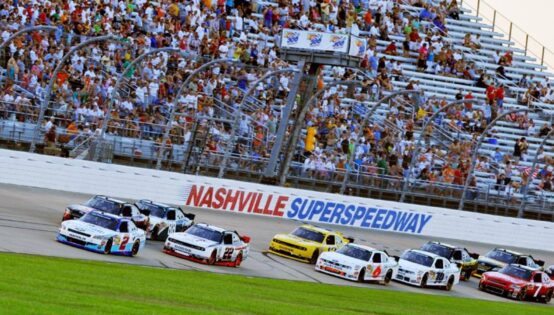Ryan Blaney finally cut through the heartbreak to claim his first Cup Series win of the 2025 season at Nashville Superspeedway. The Cracker Barrel 400 was a showcase of determination, with Blaney leading 139 of 300 laps and sealing the deal after a 103-lap green-flag run to the finish. Fans in the stands erupted as he climbed atop his car, arms raised in triumph, before handing the checkered flag to an eager young fan. But while the drama unfolded, millions of fans watching from home had a very different experience.
With Amazon Prime Video streaming the race as part of NASCAR’s media deal, the broadcast left no stone unturned. And yet, despite the applause, one piece of data told a completely different story. So what went down?
Amazon’s NASCAR experiment: A streaming success or a ratings misfire?
In 2025, Amazon Prime Video made its inaugural entry into live motorsports by securing exclusive streaming rights to five NASCAR Cup Series races. This marked a significant shift for NASCAR, as it was the first time the sport partnered with a streaming platform for live race coverage.
The Coca-Cola 600 at Charlotte Motor Speedway on May 25 served as Amazon’s debut race. The broadcast was met with widespread acclaim from fans, who praised the high-quality visuals, insightful commentary, and minimal commercial interruptions. The commentary team, featuring Adam Alexander, Dale Earnhardt Jr., and Steve Letarte, brought a blend of experience and chemistry that resonated with viewers.
Following the successful debut, Amazon streamed its second race, the Cracker Barrel 400 at Nashville Superspeedway on June 1. The broadcast maintained the high standards set during the Coca-Cola 600. Fans once again lauded the seamless viewing experience and in-depth analysis. The consistent quality suggested that Amazon was serious about delivering top-tier NASCAR coverage.
However, despite this fan enthusiasm, the ratings and viewership numbers tell a different story. The Cracker Barrel 400 garnered a low Nielsen rating of just 1.01, which is generally considered poor, especially for a marquee NASCAR event. For context, traditional cable broadcasts of NASCAR races usually achieve significantly higher ratings, often in the 2.0 range or above.
.@PrimeVideo got a 1.01 rating and 2.06 million viewers for Sunday’s NASCAR Cup Series @CrackerBarrel 400 at Nashville.
Last year’s race got 3.24 million on @NBC before a weather delay eventually forced the conclusion of the event to @USANetwork where it got 2.13 million. pic.twitter.com/cFAAxyJLM0
— Adam Stern (@A_S12) June 3, 2025
The viewership for this race was approximately 2.06 million. This number is notably down from last year’s 3.24 million viewers when NBC aired the event. The figures indicate that despite rave reviews, many fans might be missing out due to the streaming-only format or reluctance to subscribe to Prime Video just for the five races on this year’s calendar.
As Amazon prepares to stream the remaining races in its package, including events at Michigan, Mexico City, and Pocono, the key question remains. Can Prime Video sustain and grow its NASCAR audience, or will the challenges of streaming hinder its long-term success in motorsports broadcasting? Dale Jr. seems to be banking on the tech giants still, though…
Ratings aside, Dale Jr. reveals what sets Prime Video apart in NASCAR coverage
Dale Earnhardt Jr. has been vocal about the advantages of Amazon Prime Video’s NASCAR broadcasts. On several occasions, he has highlighted aspects that differentiate the streaming service from traditional broadcasters like FOX. One of the standout features, according to Dale Earnhardt Jr., is the seamless integration of pre-race and post-race coverage.
He noted, “Before we come on air with the pre-race show, they basically just turn the cameras on and turn the stream on and just capture ambient sounds and video. The stream is up—if you click the thumbnail on Amazon Prime, it puts you in the racetrack: the garage, cameras roaming around, showing you what’s going on. You’re literally seeing everything that’s happening.” This approach allows fans to experience the atmosphere of the racetrack in real-time, providing an immersive experience. Much before and after the main action starts and ends.
Another significant advantage is Prime Video’s commitment to minimizing commercial interruptions during green-flag racing. While traditional broadcasts often cut to full-screen commercials, Prime Video employs a double-box format, displaying ads in a corner while keeping the race in focus. This method ensures that viewers don’t miss critical moments on the track, enhancing the overall viewing experience.
Beyond the technical aspects, Prime Video’s investment in high-quality production values has been evident. The streaming service has a history of delivering polished broadcasts across various sports. This includes the NFL’s Thursday Night Football and the NBA since 2017. Their experience in live sports streaming has translated well into their NASCAR coverage, offering fans a broadcast that is both professional and engaging.
With these innovations, Prime Video is setting a new standard for NASCAR broadcasts, focusing on fan experience and race coverage. As the season progresses, it will be interesting to see how these advancements influence viewer engagement and whether other broadcasters will adopt similar approaches.
The post Despite Massive Fan Uproar, Amazon Prime Fails Miserably at NASCAR’s Nashville Race appeared first on EssentiallySports.
